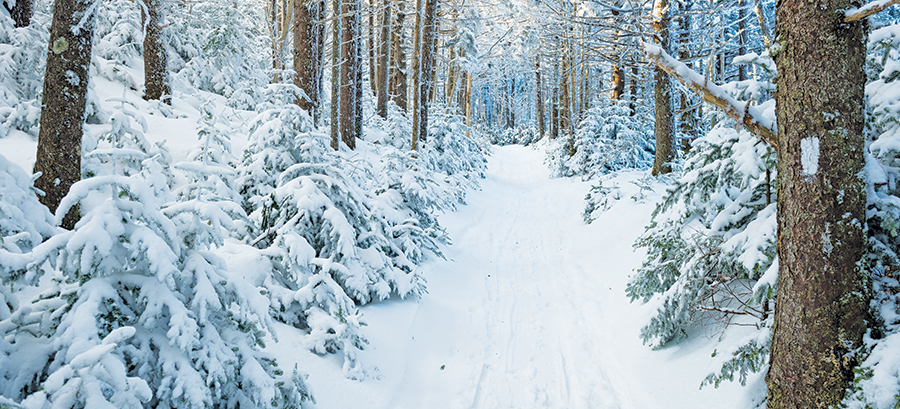Simple Life
The Winter Woods
Among the bare-branched trees, nature speaks my favorite language
By Jim Dodson
Half a century ago, a beautiful, 50-acre woodland lay just beyond the backyard of the house where I presently live, which happens to be two doors from the one in which I grew up. That patch of suburban woods was full of wildlife — birds, deer, skunks, foxes, rabbits — and a winding creek where a small universe of aquatic life thrived. As a kid, those woods were my enchanted kingdom.
The eccentric millionaire who owned those woods vowed he would never allow them to be developed. But his body was barely in the ground before his heirs sold it off to a residential developer. The forest fell, and a new subdivision quickly rose, a story repeated endlessly across 1970s America. Fortunately, I was off to college by then and spared the sadness of watching my boyhood woods systematically plowed under.
That vanished woodland was neither the first nor last magical forest that shaped my sensibilities, however. During the first seven years of my life, during my old man’s career as a newspaper executive, our family lived in a succession of small towns across the Deep South, places where fields and woods were always a short walk away. I was drawn to them like a child from a Yeats poem.
In summer, the woods teemed with life. But curiously, it was the winter woods that fascinated me most. The quiet of the forest and the bareness of leafless trees amplified natural sounds and made seeing birds and movement easier. Even before I came to understand that life underfoot was actually busier than ever, I was drawn to the stark beauty and solitude of winter.
Scarce wonder after seven years of unceasing work as an investigative journalist in Atlanta, I took an arts fellowship in the Blue Ridge Mountains and subsequently fled to a bend of the Green River in Vermont, where I lived in a small house heated by a wood stove and fell even deeper under the spell of winter in the Great North Woods.
It was there I walked snow-covered dirt roads in blue Arctic dusks with my young dog, Amos, and snow-shoed through the forest for the first time. During that quietest of all winters, I studied trees, read the complete works of a dozen poets, plus most of my favorite childhood books for the umpteenth time.
Within five years, I’d built a post-and-beam house for my young family in a vast woodland of beech and hemlock on a coastal hill in Maine. Our closest neighbor was one-quarter mile distant. Winter nights were dark, cold and full of stars so crisp and vibrant you could almost reach up and touch them.
Come the sub-zero nights of January, when a step on a wooden porch could sound like a pistol shot, I often donned a red, wool coat and toted bags of sorghum meal through knee-deep snow to where a family of whitetail deer (and the occasional moose) waited patiently in the silver cast of the moon for a midnight feeding. In the morning, we would find thousands of hoof prints where it appeared the deer stood on hind legs and danced in the woods, or so I told our two babes with a nearly straight face. Now on the cusp of their 30s, working in faraway Los Angeles and the Middle East, respectively, they still claim to believe the deer danced in winter moonlight.
First frost was always the herald of my favorite season on the doorstep, beginning with the autumn stillness that was like that of an empty church, a cue to get my woodpile finished up and properly stacked. Ring-neck pheasants and flocks of wild turkey appeared in the yard, feeding on the last seeds of summer, seemingly unmoved by our presence in their woodland world.
Once, late for his winter nap, a medium-sized black bear crossed the ancient road directly in front of us, pausing only to glance indifferently at the dude in the goofy red coat with his small, astonished children before going on about his business.
I turned that bear into a bedtime story, with a character named Pete the Bear, who along with his bumbling partner-in-crime, dim-witted but good-hearted Charlie the Cub, often broke into our house whenever we were away in order to help themselves to snacks, play board games and get warm by the fire. Pete and Charlie still reside somewhere in the forested memories of my far-flung children, not to mention their winter-loving old man.
* * *
And so it was a nice surprise when, earlier this year, our friends Joe and Liz invited my wife, Wendy, and me to take a Sunday afternoon walk through the Hamilton Lakes Forest, a slim patch of urban parkland less than a mile from our house.
Joe and Liz are trained foresters and ardent naturalists. Liz knows about every native plant in the wild and Joe can tell you all sorts of wondrous things about the life of trees.
Late last winter, with traces of early spring appearing, we hiked with them up a small mountain near Asheboro, topped by giant stone monoliths that looked like columns from lost temples or bowling pins left by the gods. Joe explained that the unusual stones were visible for miles, navigational landmarks used by migratory birds and ancient native people in their annual seasonal movements from highland meadows to winter quarters in the flatlands, sacred grounds used for their spiritual observances.
There were even traces of a vanished farmstead, not unlike the hilltop where I built my house in Maine, evidenced by wild narcissus that grew in patches around a crumbling stone foundation. Daffodils reportedly found their way to the Americas via Holland about 1800, though how they found their way to that ancient hilltop in Randolph County will probably forever remain a mystery.
“Humans come and go,” Joe summed up the moment. “But the earth and forest keep their own secrets.”
Our Sunday afternoon walk through the Hamilton Forest wasn’t quite so wild, though it was revelatory in its own ways. Joe and I talked about our grown children and how to identify trees by their bark, old maples and beeches in particular, while Liz and Wendy walked ahead of us chatting about grandchildren and, well, whatever else a pair of wise and worldly female friends talk about on a winter Sunday afternoon with their husbands lagging well behind.
At one point, Joe stopped dead and tilted his head to the bare limbs above us. “Listen. Hear that?” I did. He explained it was the perfect, three-note call of a white-throated sparrow, a bird famous for its melodic winter song.
That seemed the perfect coda. On that tri-note, we shared a nip of good Kentucky bourbon.
We rounded a lake and started back as the light grew thinner and longer. As the temperature dropped, we listened to woodpeckers patiently at work, spotted squirrel nests high in the leafless forest and greeted walkers with leashed dogs hurrying the opposite way through the woods, eager to reach home and warmth. OH
Jim Dodson is the founding editor of O.Henry magazine.


